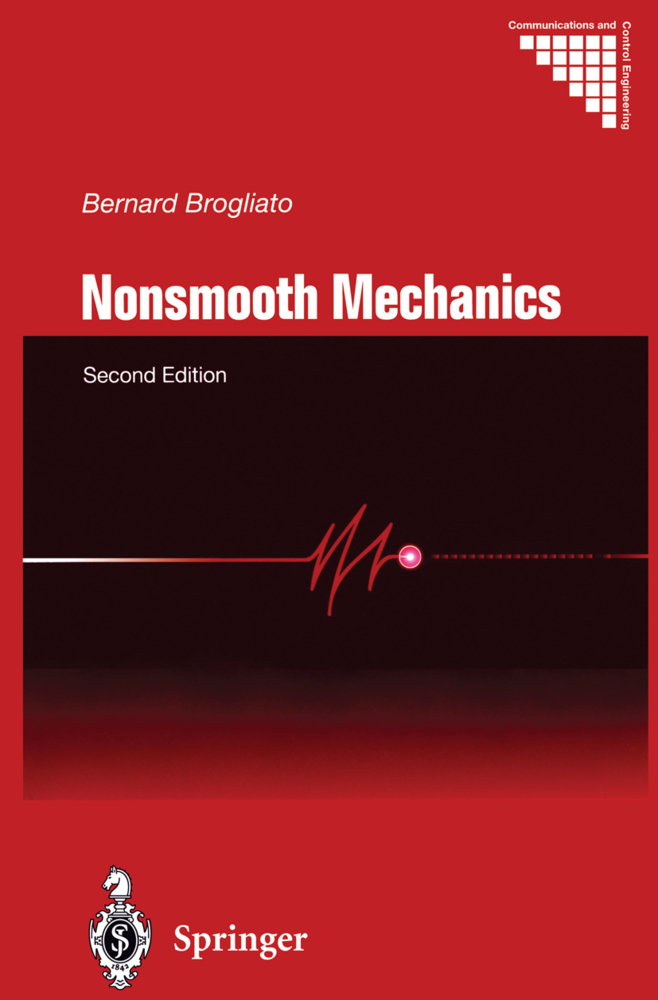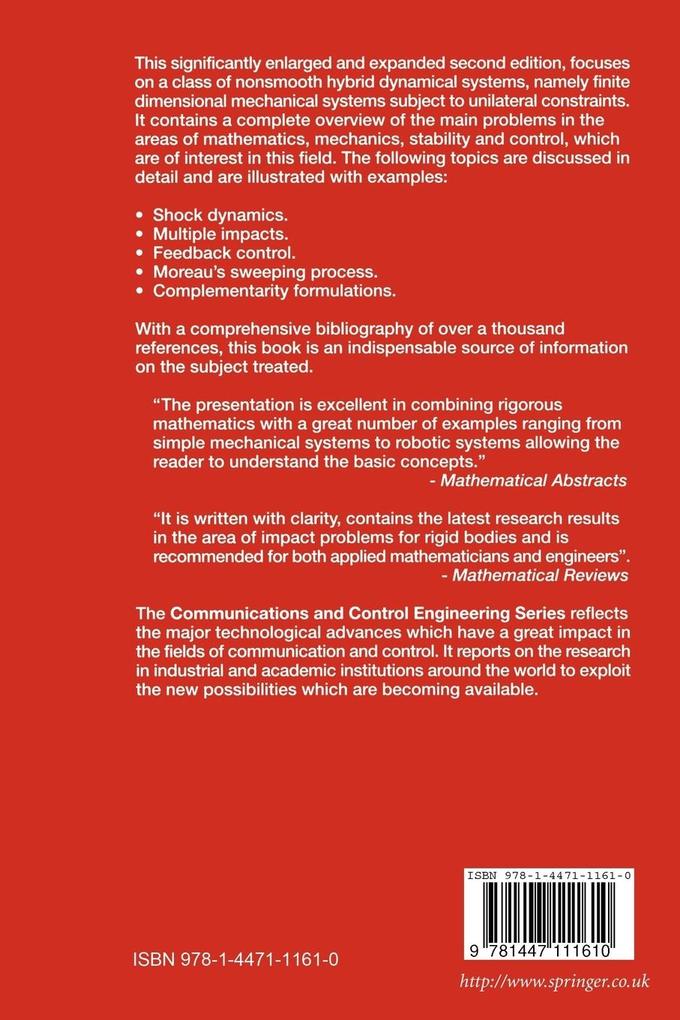Bücher versandkostenfrei*100 Tage RückgaberechtAbholung in über 100 Filialen

Zustellung: Mi, 29.10. - Fr, 31.10.
Versand in 4 Tagen
VersandkostenfreiBestellen & in Filiale abholen:
Thank you for opening the second edition of this monograph, which is devoted to the study of a class of nonsmooth dynamical systems of the general form: ::i; = g(x, u) (0. 1) f(x, t) 2: 0 where x E JRn is the system's state vector, u E JRm is the vector of inputs, and the function f (-, . ) represents a unilateral constraint that is imposed on the state. More precisely, we shall restrict ourselves to a subclass of such systems, namely mechanical systems subject to unilateral constraints on the position, whose dynamical equations may be in a first instance written as: ii= g(q, q, u) (0. 2) f(q, t) 2: 0 where q E JRn is the vector of generalized coordinates of the system and u is an in put (or controller) that generally involves a state feedback loop, i. e. u= u(q, q, t, z), with z= Z(z, q, q, t) when the controller is a dynamic state feedback. Mechanical systems composed of rigid bodies interacting fall into this subclass. A general prop erty of systems as in (0. 1) and (0. 2) is that their solutions are nonsmooth (with respect to time): Nonsmoothness arises primarily from the occurence of impacts (or collisions, or percussions) in the dynamical behaviour, when the trajectories attain the surface f(x, t) = O. They are necessary to keep the trajectories within the subspace = {x : f(x, t) 2: O} of the system's state space.
Inhaltsverzeichnis
1 Distributional model of impacts. - 1. 1 External percussions. - 1. 2 Measure differential equations. - 1. 3 Systems subject to unilateral constraints. - 1. 4 Changes of coordinates in MDEs. - 2 Approximating problems. - 2. 1 Simple examples. - 2. 2 The method of penalizing functions. - 3 Variational principles. - 3. 1 Virtual displacements principle. - 3. 2 Gauss principle. - 3. 3 Lagrange s equations. - 3. 4 External impulsive forces. - 3. 5 Hamilton s principle and unilateral constraints. - 4 Two bodies colliding. - 4. 1 Dynamical equations of two rigid bodies colliding. - 4. 2 Percussion laws. - 5 Multiconstraint nonsmooth dynamics. - 5. 1 Introduction. Delassus problem. - 5. 2 Multiple impacts: the striking balls examples. - 5. 3 Moreau s sweeping process. - 5. 4 Complementarity formulations. - 5. 5 The Painlevé s example. - 5. 6 Numerical analysis. - 6 Generalized impacts. - 6. 1 The frictionless case. - 6. 2 The use of the kinetic metric. - 6. 3 Simple generalized impacts. - 6. 4 Multiple generalized impacts. - 6. 5 General restitution rules for multiple impacts. - 6. 6 Constraints with Amontons-Coulomb friction. - 6. 7 Additional comments and studies. - 7 Stability of nonsmooth dynamical systems. - 7. 1 General stability concepts. - 7. 2 Grazing orC-bifurcations. - 7. 3 Stability: from compliant to rigid models. - 8 Feedback control. - 8. 1 Controllability properties. - 8. 2 Control of complete robotic tasks. - 8. 3 Dynamic model. - 8. 4 Stability analysis framework. - 8. 5 A one degree-of-freedom example. - 8. 6ndegree-of-freedom rigid manipulators. - 8. 7 Complementary-slackness juggling systems. - 8. 8 Systems with dynamic backlash. - 8. 9 Bipedal locomotion. - A Schwartz distributions. - A. 1 The functional approach. - A. 2 The sequential approach. - A. 3 Notions of convergence. - B Measures and integrals. - C Functions ofbounded variation in time. - C. 1 Definition and generalities. - C. 2 Spaces of functions of bounded variation. - C. 3 Sobolev spaces. - D Elements of convex analysis.
Produktdetails
Erscheinungsdatum
05. Oktober 2012
Sprache
englisch
Auflage
Second Edition 1999
Seitenanzahl
552
Reihe
Communications and Control Engineering
Autor/Autorin
Bernard Brogliato
Illustrationen
XX, 552 p.
Verlag/Hersteller
Produktart
kartoniert
Abbildungen
XX, 552 p.
Gewicht
872 g
Größe (L/B/H)
31/155/236 mm
ISBN
9781447111610
Entdecken Sie mehr
Pressestimmen
From reviews for the first edition:
It is written with clarity, contains the latest research results in the area of impact problems for rigid bodies and is recommended for both applied mathematicians and engineers.
Mathematical Reviews 1998f (Reviewer: P. D. Panagiotopoulos)
The presentation is excellent in combining rigorous mathematics with a great number of examples ranging from simple mechanical systems to robotic systems allowing the reader to understand the basic concepts.
Mathematical Abstracts (Reviewer: H. Troger)
Bewertungen
0 Bewertungen
Es wurden noch keine Bewertungen abgegeben. Schreiben Sie die erste Bewertung zu "Nonsmooth Mechanics" und helfen Sie damit anderen bei der Kaufentscheidung.










